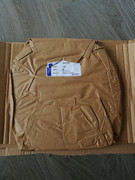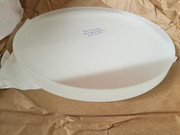Forum Replies Created
-
AuthorPosts
-
But then apologizes, the second method as it does to operate? (I do not open the link, After I try from home). The discs have the diamond part just on the edge… The first method with the flange I had seen him, but does not inspire me much… With a tool diameter sub how it would change the type of pass for the roughing step?
Actually the base with the ballast inside, eg bricks, it adapts to the floor and has no movement whatsoever… With felt pads scattered here in the tiles of the house it is perfect. However I could also put on some feet but at the moment I don't feel the need.
What do you mean?
Well anyway I think in the future as I could evaluate it as in software, electronics and mechanics would not have major problems to do some experiments

Maybe combining it all with your knowledge might come out something interesting no?
Now I will concentrate on my blank and its manual processing and preparatory, but it is something we'll talk…
You could make the positive with a 3D printer, then the negative plaster and then fill it with glass powder…

Hi Nicola, welcome! And enjoy your work!

Great, do we now look. Instead they send me pitch is marked “Pitch 26°”, it's right?
Maximus the blank is borofloat 33 but I do not think it is annealed. The glass problem as the tool is that I very much costs. I'm not going to pay 85 euro for a calcium sodium blank 19mm without even the edges machined. The prices you find are those, glassworks in my area not even consider me for such work. If industrial glassworks not even get confused for a disc 30cm, if they are common and glass works have not even have to order it or they will cut badly and still pay a blunder. It's not about the money itself but it annoys me just rub me… Pay a calcium sodium glass almost as much of a blank 25mm it seems like a scam borosilicate.

The only flaw (so if we can call it) that I can find us, as a simple reader of Bartolomei Mirco's article on the sizing of any baffles and hoods, concerns the necessity in case of shortened truss structure, to put on a longer hood, just as in the case of a shortened monolithic tube it would be necessary to add protection since the eyepiece would no longer be parallel to the horizon but directed at a much greater angle.
This seems to me a good solution to take advantage of a greater focal length! From what you write there don't seem to be any optical or mechanical problems. So I wonder, why this solution is not used commercially?

In the end then I took a 300mm blank and 25 thick borofloat glass 33, so I'll have to make the tools… My doubt remains precisely the focal length. I was now sure of making an f5 but maybe an f6 wouldn't be a bad choice, it would allow me more enlargements if I decided to do even a little’ of planetarium. And on the deep, nothing would change me. Undecided.Thank you, I would gladly read it… I have actually seen images of different forms of support that minimize this effect. Anyway, the glass experiment could work or in your opinion could give problems?
Here, an OT thing, studying the obstruction due to the secondary and its support, I noticed that the main problem lies not so much in the reduction of light as in the refraction of the same, especially on the spider that generates those crosses of light on the image. I was thinking, but if in place of the spider or other squats, to support the secondary, I used a glass disc with excellent transparency, excellent leveling, a few mm thick and the use of a lens hood to avoid light sources coming out of the optics field, what problems could I run into?
Ok, therefore it can be said that, removing the observer's needs, in visual, a longer focal length instrument would be objectively preferable but subjectively it may not be for x factors. To simplify, if one does not need very open fields or particular geometries to be respected, there is no point in aiming for fast focal lengths.
It is clear that for large diameters it becomes an obligation to stay low… making a dob from 60cm f7 would become geometrically a bit problematic
However, I noticed that a value changes by changing the focal length, all other conditions being equal. While the angular resolution remains the same, the calculation of the linear resolution gives a higher value with the lower focal length. Why? These are things that can be found visually? -
AuthorPosts

